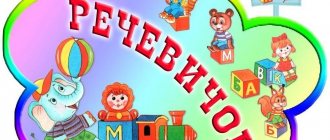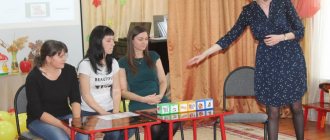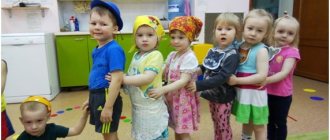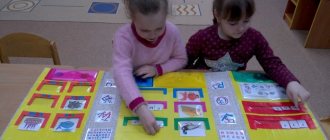There is no certain period of time during which one can and should intensively engage in the development of speech - and that’s it - as if by a wave of a magic wand, the baby took and spoke in whole sentences. This is a rather lengthy process and takes its own time for each individual child.
Parents lay the foundations on which knowledge and skills are laid like bricks. Speech development is not only dealt with from one to two years of age, until the child speaks - this is a process that has no clear boundaries. Many adults are actively developing and improving their speech and speech skills.
Factors on which speech development depends
Each child is individual, but psychologists and speech therapists identify four main factors that influence speech development:
- Anatomical features - the correct structure and functioning of the speech apparatus (tongue, palate, larynx, vocal folds), correct breathing.
As soon as the baby is born, he is immediately examined by a neonatologist and pediatrician, and during the first year of life by other specialists - a neurologist, dentist, etc. This is done in order to exclude various birth defects, to identify any diseases or predispositions in the early stages, and also prevent the development of the disease.
If deviations from normal development are detected, the doctor will be able to recommend correcting the anatomical defect, or preparing for subsequent correction. For example, a shortened frenulum does not allow the tongue to fully move in the oral cavity, and it does not reach the palate. Thus, it predetermines the occurrence of incorrect sound pronunciation.
- Physiological component. The connection between the brain and fine motor skills has long been proven - by developing small hands, you can activate speech centers.
There are a huge number of finger games and activities aimed at developing tactile sensations (various cereals, objects of different shapes and sizes, etc.). The most well-known and beloved game is “Magic Bag”.
- Emotional component. This is, first of all, a close emotional connection with mom and dad.
It is considered ideal for a child to communicate with grandparents (on both sides), brothers and sisters. The more the baby communicates with his family, the faster he joins in the conversation with them (he will wink at some, “hug” at others, and say something to others).
- Social component. First, the baby begins to communicate with his parents by screaming, when this is the only way he can say that he is experiencing discomfort, then, when recognizing familiar faces, he fixes his gaze, begins to smile, reaches out with his arms, etc. Therefore, everything that the child does is important - be sure to express emotionally your joy, tenderness, admiration.
In addition, in addition to the above factors, many specialists (speech therapists, psychologists, speech pathologists) indicate the influence of the speech of others - especially correct from the point of view of phonetics. For example, if one of the parents “burrs,” then most likely the son or daughter will do this based on imitation of a significant adult. In this case, it is advisable to correct the pronunciation of the sound P in parallel between the child and the adult.
What is mnemonics?
Mnemonics – literally translated from Greek means “the art of memorization.” This is a certain system of techniques and methods, the action of which is aimed at the most effective preservation, reproduction and memorization of the received material.
The name of this technique is absolutely no coincidence - it comes from the name of the ancient Greek goddess of memory, logic and prudence named Mnemosyne. Mnemonics is a popular technique, the essence of which is the most accelerated development of coherent speech, based on the visual perception of information with its further reproduction using images.
The main point of using a mnemonic table for children is the following: to determine a specific word or phrase, a specific image (picture) is used, with the help of which a schematic sketch of the word is made. By carefully studying the presented images, the child can quickly memorize and reproduce text material, which helps the development of speech for preschoolers.
How a child’s speech is formed from birth to 3 years
The baby learns to communicate with the outside world from the very moment of birth. Let's take a look at how the speech development of young children occurs during the first 3 years of a child's life.
Norms of speech development in children from 0 to 3 years old
- 0 – 2 months. Scream. The first form of communication for a child is crying. The baby cries when he is hungry, uncomfortable or tired.
- 2 – 3 months. Booming. Crying is replaced by cheering. The sounds “a”, “s”, “u” appear, sometimes in combination with “g”. The child learns to understand speech addressed to him and control his own sound intonations.
- 3 – 6 months. Babble. The baby begins to babble to himself and make sounds when addressed to him. Turns his head towards the sound. Freezes in response to a sudden loud sound. Cries differently depending on needs: “I’m hungry,” “I’m tired.” Recognizes his name and reacts to it.
- 6 months. First syllables. From the age of 6 months, you can notice that the child prefers strictly certain sounds to all others: “ba”, “ma” (they are the easiest to learn to pronounce). He can repeat them endlessly: he likes the way they sound.
- 7 – 9 months. Combinations of syllables. The babbling progresses to the utterance of identical syllables: “ma-ma-ma”, “dya-dya-dya”, “ba-ba-ba”.
- 9 – 11 months . Onomatopoeia. The baby imitates the sounds of adults' speech. Responds to name. Understands the meaning of the word “no.”
- 11 – 13 months. The first meaningful words from two identical syllables: “dad”, “mom”, “baba”, “uncle”.
- 12 months. The baby shows interest and attention to the speech of others, repeats and combines sounds in a new way, combines them into “words”, imitating the speech of an adult. Understands and follows simple one-word instructions (“sit down”). He waves his hand “bye-bye”, shakes his head “no”. Uses gestures and sounds to attract attention. Interested in books.
Rarely does a parent know what signs indicate deviations in the child’s development. Therefore, for prevention, be sure to visit a pediatric neurologist at 3, 6, 9 and 12 months .
- 18 months. The baby easily repeats frequently heard words. Knows different parts of the body and points to them. Masters simple words (by the age of 2 years, their vocabulary can range from 20 to 50). Answers in words or gestures the questions: “Where is the bear?”, “What is this?” He loves when people read to him. At the request of an adult, he points his finger at the pictures in the book. 2 years. First sentences (two words). A two-year-old child can easily combine simple words mastered by the age of 2 into combinations: “Mom, give me,” “I want this,” “Where is the kitty?” Understands simple instructions consisting of two sequential actions: “Find your teddy bear and show it to grandma.” The vocabulary can expand to 150 - 200 lexemes, and others can already understand half of the words the child pronounces. The baby begins to use pronouns, adjectives and prepositions. Holds a book correctly in his hands. “Reads” to his toys.
- 3 years. Multi-word sentences (three or more words). At 3 years old, the period of early childhood ends. By this turning point, the child is able to compose sentences of three or more words. Distinguishes between colors and size definitions. Remembers and repeats familiar rhythms, melodies, stories. Some difficulties in sound pronunciation may still persist (whistling, hissing, vowel sounds). The vocabulary is expanding so much that parents can no longer accurately count how many words it consists of. In general, the baby is already ready to speak out on any occasion.
Production of mnemonic tables
Making educational mnemonic tables for speech development does not require any special skills or artistic talent. A word or short phrase is selected, as well as an image that will clearly illustrate the selected word.
For children of primary preschool age, it is best to use tables with bright, colorful pictures - thanks to images of a squirrel, bunny or flower, the child remembers the material much faster and easier.
After some time, after the children have carefully studied the phrase and the image that characterizes it, you can replace the picture with graphic symbols. For example, draw a Christmas tree with a green triangle, and a hare with a gray or blue circle. Below is shown how, using the example of the fairy tale “Ryaba Hen,” you can make mnemonic tables with gradual complication in the form of replacing pictures with graphic symbols:
Mnemonic table with pictures only.
Add some graphic symbols.
Replace all pictures with graphic symbols.
Most often, for the development of coherent speech in preschool children, ready-made diagrams and tables developed by V.K. Vorobyova or T.A. Tkachenko. But it is worth remembering that such model schemes cannot be called universal - they can only become the basis in the learning process of each individual child. The teacher can independently refine, improve and correct ready-made model diagrams.
In most cases, educational mnemonic tables are used to teach children the main features of a particular subject. Therefore, the main topics in such tables may be the study of the color, shape, size, texture (soft or hard) of a particular object. In addition, the educational mnemonic table can answer the following question:
- What elements does this item consist of?
- What is this thing used for?
- What can you do with this item and what can’t you do with it?
This is an approximate list of questions that the child should answer after studying cards with images and mnemonic tables.
Types of speech
Speech can be active or passive:
- Active - the one that the baby uses. The child knows the words he has learned, can confidently pronounce them, and construct sentences with their help.
- Passive is the one that the child understands, but for certain reasons does not pronounce. For example, he may know the word “TV”, but not say it because it is difficult for him.
It is very important to develop both active and passive speech of a child.
How to help develop speech by age
Up to a year old, the baby makes his first attempts to speak - he smiles in response to visual and verbal contact with adults, tries to say some sound or even repeat after mom or dad. Therefore, it is very important to focus on these attempts, smile, look at the baby, showing in every possible way that you are interested.
1-3 years. At this age, mothers and fathers, when communicating with a child, try (on an unconscious level) to speak to the baby in his language - briefly, understandably, clearly. Thus, the child understands what is being said to him, what he wants to say. Try to get rid of baby talk and empty repetition (such as “ba-ba”, “peek-a-boo”). The child must hear the words in full so that later he can say them the same way, and not shorten the syllables, rearrange them, distorting the meaning. Correct speech stimulates communication.
From 3 years and older. The most common opinion of most modern parents is that by sending a three-year-old child to kindergarten, the pace of communication can be slowed down, and all the necessary speech skills will be developed by the employees of the child care institution. This is wrong. Parental communication remains just as important, because it is in the family that the foundations of communication are laid, on which the rest of the acquired knowledge will be superimposed.
First phrases
An important stage in speech development is the acquisition of phrasal speech in preschool age. By the age of 1.5–2 years, simple two-word phrases usually appear in speech. The vocabulary is actively increasing, verbs, prepositions, and adverbs are being used. At 2-3 years old, children begin to use adjectives. The age of 3-5 years is often called the age of “why”. During this period, children are interested in everything, eagerly learn about the world around them and, accordingly, ask adults many questions.
If at this age the child does not have phrasal speech, you should consult a specialist. Developmental activities will help fill in the gaps and lay the foundation for the further development of your baby’s speech.
To develop your child’s phrasal speech, you can do the following:
- Read books to your child that are appropriate for his age;
- Look at the pictures;
- Listen to music with your child, sing songs, dance;
- Answer the child’s questions and support his research interest;
- Provide the child with new impressions, discuss what he sees;
- Monitor the purity of your own speech;
- Encourage communication with children.
There are also a number of games and exercises that contribute to the development of a child’s speech. These include:
- Games to develop fine motor skills;
- Articulation gymnastics;
- Finger gymnastics.
You can get acquainted with these and many other useful exercises in classes at. The good thing about these games is that you can play them at home yourself. They not only have a beneficial effect on speech development, but also develop the baby’s attention, memory, and thinking. Perform only those exercises that evoke positive emotions in you and your child, do it unobtrusively and with genuine interest. The most important thing is to enjoy communicating with each other.
How to help young children develop speech
What can we, parents, do from the very birth of a child to ensure that he speaks naturally?
Let us remind you that the sensory channel for perceiving information about the external environment (vision, hearing, taste, smell and touch) is the main one for children in the first years of life.
Therefore, the answer lies on the surface: it is necessary to give the child as much information as possible about the world around him, as much as possible of any kind of sensory sensations and stimuli. Let's talk about it.
- Touch. Feeling #1 at first.
Mother's warm hands, her gentle touches, stroking, massage, gymnastics, toys of different shapes and textures, finger games - the more of this, the better.
Knowledge about oneself, one’s body and its sensations is formed through contact with the environment, so diversify the child’s tactile sensations as much as possible. Water of different temperatures (carefully!), soft fabric and rubber balls, a plastic rattle and a wooden cube, finger paints on a palette, sand in a children's sandbox, beans in a jar, etc. - the world is so rich for training your sense of touch!
- Hearing.
Give your baby as much information as possible that he can perceive by ear:
- sounds of music
- nature
- household appliances in the house
- street noise from the window
- sounds of native speech, etc.
Always talk to your baby about everything. Mom does this naturally, because speech accompanies any of her actions: she voices swaddling, feeding, bathing, and putting her to bed. She names objects surrounding the child, pointing at them.
When the baby starts to walk, the mother “keeps up the conversation”: she responds to the sounds the baby makes, repeats them and introduces him to adult speech, which the baby will try to imitate as he grows up.
- Vision.
We interest the baby in the objects around him so that he learns to focus his vision and maintain his attention on significant objects.
To help your child concentrate, you can hang bright colored objects above the crib (for example, balloons, fluffy pom-poms - they are quite light and will certainly attract attention).
Some mobile models come with removable toys to help adults provide a stimulating and varied space for their child. This is for the little ones.
Later, the arsenal of objects from the surrounding reality can be replenished endlessly, both due to toys in the house, and due to the visual impressions that the baby will receive when he is outside the home: on a city street, on a river, in a forest, in a zoo.
- Taste.
Mother's milk, water, teas, juices, pureed and solid food - what a variety of textures and tastes! Introduce your baby to them by gradually expanding the range of products that you introduce into baby food. The sooner a child becomes familiar with basic tastes, the less picky he will be in food later.
Songs, rhymes and nursery rhymes for speech development in children 2 - 3 years old
These are perhaps the most effective, generation-tested ways of communicating with young children.
Basic principles:
- simple rhyme
- repetition of sounds or words
- small size
- accompaniment with gestures/actions
Rhyming poems can be told, or they can be sung using various melodies.
The main purpose of nursery rhymes, finger games, rhymes:
- emotional contact with the child
- development of his speech skills
- finger massage
- study of body parts
- assistance in establishing a routine
For example, by repeating the same rhyme before bedtime, you can develop in your child the expectation of a funny rhyme and the understanding that it is time for him to sleep.
IMPORTANT: Young children need consistency and order as this develops a sense of stability and security.
You can come up with or choose from the many available nursery rhymes, one for different occasions:
- morning hygiene procedures
rhyme for washing
- changing baby's clothes
rhyme when changing clothes
- preparation for swimming
bath rhyme
- before gymnastics
rhyme for gymnastics
- finger massage
poem for finger massage
- before bedtime
bedtime poems
The classic nursery rhymes “okay”, “cockerel-comb”, “horned goat”, “white-sided magpie” and many others will also delight the baby and be useful.
Playing and learning to speak: role-playing games for children
Options for playing with a child are limited only by the parents' imagination. At the same time, the child often independently suggests what he wants to do, distributes roles and organizes the game. Your mission is to fill the game with detailed dialogues so that the game is not only exciting, but also useful for the development of the baby’s speech. It can be:
- Hide and seek The classic game of “peek-a-boo” with infants can gradually change. You can hide behind anything, attracting the child with the words “where is mom?”, “find mom.” As the child grows up, he will begin to enjoy hiding on his own, and you, with appropriate verbal accompaniment, will look for him.
- Role-playing games At first, these can be very simple games. For example, you can play with a toy phone, a child can call mom, dad, brother, sister, say “Hello,” find out “how are you?” and vice versa. Then you can role-play fairy tales, come up with stories yourself, using household items and toys
- “Guess” There are many variations of games. You can ask your child: “guess what I’m doing?” and show some action: combing your hair, pouring tea into cups. Or ask: “guess who I am?” and depict a bunny or a bear cub. You can show soft animals and ask: “guess who it is?”, “what does he like to eat”, “where does he live?” If the child cannot answer, you should give a detailed answer yourself, and after a while repeat the questions to the child
- Active games Nursery rhymes and songs can be used in active play with the child, encouraging him to repeat the corresponding actions along with the words. This, in parallel with speech skills, will develop both the child’s physical and musical abilities. Examples:
nursery rhyme with movements 1
nursery rhyme with movements 2
Features of using mnemonic tables for teaching children
Today, mnemonics are one of the easy-to-use, easy, convenient and highly effective techniques for the development of coherent children's speech and accelerated memorization of material, which are implemented through schematic mnemonic tables and graphic images.
At the same time, this technique helps to formulate the baby’s speech, replenish his vocabulary with beautiful, complex and correctly constructed phrases and sentences. The essence of all mnemonic techniques is the transformation of textual, verbal information into visual images. Despite the fact that many preschool-aged children perceive their first lessons very painfully, believing that they will not succeed, in the future the children really enjoy the educational process. Not only is it extremely informative, but it is also very interesting, engaging and fun, like a game.
Most often, in the case of using mnemonic tables for the development of coherent speech of preschoolers in preschool institutions, the following scheme is used:
- The teacher shows the children cards with bright and colorful pictures indicating a certain phrase or sentence.
- The next stage is the study of so-called mnemonic tracks. This is a series of pictures, consisting of about four images, with the help of which the child can tell a simple story.
- The most difficult stage is the direct use of the mnemonic table for teaching coherent speech to preschoolers. Thanks to this method, preschool children learn to reproduce longer and more complex stories and stories.
Varieties of mnemonic devices for the development of coherent speech in preschoolers:
- Cards with an algorithm for certain actions - for example, the sequence of morning activities (washing, brushing teeth, breakfast, getting dressed).
- Mnemonic tracks with a series of different images that tell a specific story or story. For children of primary preschool age, fairy tales are most often used.
- Techniques for faster and easier assimilation of information and study of poetry.
An example of using the fairy tale “The Three Little Pigs”.
An example in the use of a poem.
What mistakes can parents make when developing their child’s speech?
Often the child is overly patronized and protected, they try to predict his desires - of course, out of love for him. But then the baby does not develop the desire to work independently, he does not learn to express his thoughts through speech, and many processes in his development may be inhibited.
• Intuition and love help loved ones understand a child literally at a glance. But communicating with unfamiliar people in unusual conditions will be difficult for him, and in the worst case, acutely uncomfortable. To prevent this from happening, as you grow older, you need to enter into conversations more often with new and new interlocutors, and then the child will simply be forced to improve his speech understanding skills.
• Some parents underestimate, while others overestimate, the requirements for the baby’s speech. In the first case, they do not demand anything from the child, all his wishes are guessed and immediately fulfilled, in the second, they constantly pester him: “Tell me!”, “Repeat!”. Sometimes in one family two extreme approaches are used at once: for example, dad demands, and grandmother takes care. This has a very adverse effect on the child’s speech development.
• Try to eliminate lisping, “baby talk,” and constant onomatopoeia when communicating with your baby. The parent's speech is a model for the child.
• Parents can speak very quickly or, conversely, too slowly, without pauses and different intonations, monotonously. It is important to use all the richness and diversity of language when developing a child’s speech.
• Do not try to speed up the baby's natural speech development. Avoid overwork from speech classes and memorization of poetry.
Common speech problems in preschool children
In most cases, girls and boys of preschool age should already be able to fully operate with synonyms and a variety of images, describe all current events, using vivid, but at the same time grammatically correct word forms. But, unfortunately, not all preschoolers can boast of such skills. Most children face various speech problems:
- Inability to compose long, complex sentences - the child’s speech consists exclusively of simple, laconic sentences.
- The child cannot independently formulate a logically correct and complete sentence.
- Systematic use of non-literary vocabulary.
- Minimal, poor vocabulary that does not correspond to the child’s age category.
- A preschooler cannot independently formulate questions and answer questions posed.
- Poor level of diction.
- A preschooler cannot draw correct logical conclusions and statements.
To correct such speech defects, mnemonics are often used, which have become widespread among many specialists.






